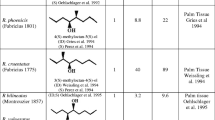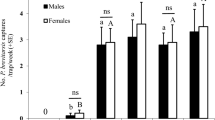Abstract
Laboratory and field investigations to identify and evaluate plant co-attractants of the aggregation pheromone of the date palm pest Oryctes agamemnon are reported. Volatiles emitted by freshly cut palm core and palm core with feeding males, were collected, analyzed by gas chromatography coupled to mass spectrometry and evaluated in olfactometers alone or combined with synthetic pheromone. A collection of palm odor without male effluvia was attractive alone and enhanced attraction to synthetic pheromone in an olfactometer similar to that to a collection of palm odor emitted with feeding males and containing natural pheromone. Behavioral responses to collections of palm volatiles were correlated to the amount of volatiles material in them. Enhancement of the attractiveness of the pheromone was not correlated to chemicals specific to beetle feeding. The chemicals common to the active collections extracts were benzoate esters, mostly ethyl benzoate, anisole derivatives and sesquiterpenes. Blends of the most abundant components of the extracts were evaluated for enhancement of the attractiveness of pheromone (1 μg) in olfactometers at 1 or 10 μg doses. The mixtures were further evaluated by field trapping in Tunisia at 3–10 mg/day using reference (6 mg/day) or experimental pheromone formulations. A mixture of ethyl benzoate, 4-methylanisole and farnesol (1:1:1 w/w at 6.5 mg/day) enhanced captures in pheromone baited traps in 2014 and 2015 and this mixture was as active as the natural palm bait. The practical prospect of the result for the management for O. agamemnon, and other palm beetles is discussed.




Similar content being viewed by others
References
Alfiler ARR (1999) Increased attraction of Oryctes rhinoceros aggregation pheromone, ethyl 4-methyloctanoate, with coconut wood. Coconut Res Dev 15:131–149
Allou K, Morin J-P, Kouassi P, Halan’klo F, Rochat D (2006) Oryctes monoceros trapping with synthetic pheromone and palm material in Ivory Coast. J Chem Ecol 32:1743–1754
Allou K, Morin J-P, Kouassi P, Halan’klo F, Rochat D (2008) Sex ratio and female sexual status of the coconut pest, Oryctes monoceros (Coleoptera: Dynastidae), differ in feeding galleries and pheromone-baited traps. Bull Entomol Res 98:581–586
Bedford GO (1980) Biology, ecology and control of palm rhinoceros beetles. Annu Rev Entomol 25:309–339
Bedford GO, Al-Deeb MA, Khalaf MZ, Mohammadpour K, Soltani R (2015) Dynastid Beetle Pests. In: Wakil W, Faleiro JR, Miller TA (eds) Sustainable Pest Management in Date Palm: Current status and emerging Challenges. Springer, Cham, pp 73–108
Borse BB, Rao LJM, Ramalakshmi K, Raghavan B (2007) Chemical composition in volatiles from coconut sap (neera) and effect of processing. Food Chem 101:877–880
Byers JA (1992) Optimal fractionation and bioassay plans for isolation of synergistic chemicals: the subtractive-combination method. J Chem Ecol 18:1603–1621
R Core Team (2014) R: A language and environment for statistical computing. R Foundation for Statistical Computing, Vienna. <http://www.R-project.org>
Dechambre RP, Lachaume G (2001) Dynastidae: Le genre Oryctes. P. 89. Hillside books, Compiègne, France
Ehsine M, Belkadhi MS, Chaeib M (2009) Bio-ecologic observations on rhinoceros beetle Oryctes agamemnon (Burmeister 1847) on the palm dates oasis of Rjim Maâtoug in South-western Tunisia. J Arid Land Stud 19:379–382
El-Sayed AM (2016) The Pherobase: Database of pheromones and semiochemicals <http://www.pherobase.com>
El-Sayed AM, Suckling DM, Wearing CH, Byers JA (2006) Potential of mass trapping for long-term pest management and eradication of invasive species. J Econ Entomol 99:1550–1564
El-Sebay Y (2003) Ecological studies on the red palm weevil, Rhynchophorus ferrugineus Oliv (Coleoptera: Curculionidae) in Egypt. Egypt J Agric Res 81:523–529
Endrödi S, Petrovitz R (1974) Die Arten und Rassen der Gattung Oryctes Illiger in Iran. Entomol Phytopathol Appl (Iran) 36:4–19
Faleiro JR, Satarkar VR (2005) Attraction of food baits for use in red palm weevil, Rhynchophorus ferrugineus Olivier pheromone traps. Indian J Plant Prot 33:23–25
Faucher CP, Hilker M, De Bruyne M (2013) Interactions of carbon dioxide and food odours in Drosophila: olfactory hedonics and sensory neuron properties. PLoS One 8:e56361
Gries G, Gries R, Perez AL, Oehlshlager AC, Gonzalez LM, Pierce HD Jr, Zebeyou M, Kouame B (1994) Aggregation pheromone of the African rhinoceros beetles, Oryctes monoceros (Olivier) (Coleoptera: Scarabaeidae). Z Naturforsch 49c:363-366
Groupement Interprofessionnel des Fruits (GIF) (2014) Rapport annuel des activités du Ministère de l’Agriculture, des Ressources Hydrauliques et de la Pêche (Tunisia). Janvier 2014:30
Hallem EA, Ho MG, Carlson JR (2004) The molecular basis of odor coding in the Drosophila antenna. Cell 117:965–979
Hallett RH, Perez AL, Gries G, Gries R, Pierce HD Jr, Yue J, Oehlschlager AC, Gonzalez LM, Borden JH (1995) Aggregation pheromone of the coconut rhinoceros beetle, Oryctes rhinoceros (L.) (Coleoptera: Scarabaeidae). J Chem Ecol 21:1549–1570
Khoualdia O, Rhouma A, Marro J-P, Brun J (1997) Première observation sur Oryctes agamemnon, ravageur de palmier dattier en Tunisie. Fruits 52:111–115
Knudsen JT, Eriksson R, Gershenzon J, Ståhl B (2006) Diversity and distribution of floral scent. Bot Rev 72:1–120
Kreher SA, Mathew D, Kim J, Carlson JR (2008) Translation of sensory input into behavioral output via an olfactory system. Neuron 59:110–124
Lepesme P (1947) Les insectes des palmiers. P. 903. Paul Lechevalier Ed., Paris
Lin H, Phelan PL (1991) Identification of food volatiles attractive to dusky sap beetle, Carpophilus lugubris (Coleoptera: Nitidulidae). J Chem Ecol 17:1273–1287
Mohammadpour K, Avand-Faghih A (2008) Investigation on the possibility of co-mass trapping of the populations of red palm weevil, Rhynchophorus ferrugineus and date palm fruit stalk borer Oryctes elegans using pheromone traps. Appl Entomol Phytopathol 75:39–53
Morin J-P, Rochat D, Malosse C, Lettere M, Desmier De Chenon R, Wibowo H (1996) Ethyl 4-methyloctanoate, major component of Oryctes rhinoceros (L.) (Coleoptera, Dynastidae) pheromone. C R Acad Sci III-Vie 319:595–602
Oehlschlager C (2007) Optimizing trapping of palm weevils and beetles. Acta Hortic 736:347–368
Oehlschlager AC, Chinchilla C, Castillo G, Gonzalez L (2002) Control of red ring disease by mass trapping of Rhynchophorus palmarum (Coleoptera: Curculionidae). Fla Entomol 85:507–513
Reisenman CE, Lei H, Guerenstein PG (2016) Neuroethology of olfactory-guided behavior and its potential application in the control of harmful insects. Front Physiol 7:271. doi:10.3389/fphys.2016.00271
Rhouma A (1993) Le palmier dattier en Tunisie : Un secteur en pleine expansion. In: Ferry M, Greiner D (eds) Le palmier dattier dans l'agriculture d'oasis des pays méditerranéens. CIHEAM, (Options Méditerranéennes : Série A. Séminaires Méditerranéens n° 28) pp 85–103
Rochat D, González AV, Mariau D, Villanueva AG, Zagatti P (1991) Evidence for male-produced aggregation pheromone in American palm weevil, Rhynchophorus palmarum (L.) (Coleoptera: Curculionidae). J Chem Ecol 17:1221–1230
Rochat D, Nagnan-Le Meillour P, Esteban-Duran JR, Malosse C, Perthuis B, Morin J-P, Descoins C (2000a) Identification of pheromone synergists in American palm weevil, Rhynchophorus palmarum, and attraction of related Dynamis borassi (Coleoptera, Curculionidae). J Chem Ecol 26:155–187
Rochat D, Ramirez-Lucas P, Malosse C, Aldana R, Kakul T, Morin J-P (2000b) Role of solid-phase microextraction in the identification of highly volatile pheromones of two rhinoceros beetles Scapanes australis and Strategus aloeus (Coleoptera, Scarabaeidae, Dynastinae). J Chromat A 885:433–444
Rochat D, Morin J-P, Kakul T, Beaudoin-Ollivier L, Prior R, Renou M, Malosse I, Stathers T, Embupa S, Laup S (2002) Activity of male pheromone of Melanesian rhinoceros beetle Scapanes australis. J Chem Ecol 28:479–500
Rochat D, Mohammadpoor K, Malosse C, Avand-Faghih A, Lettere M, Beauhaire J, Morin J-P, Pezier A, Renou M, Abdollahi GA (2004) Male aggregation pheromone of date palm fruit stalks borer Oryctes elegans. J Chem Ecol 30:387–407
Rodríguez C, Oehlschlager AC, Chinchilla CM (2016) Examination of critical components of Rhynchophorus palmarum pheromone traps. Technical note. ASD Oil Palm Papers 46:15–19
Said I, Aldana De La Torre R, Morin J-P, Rochat D (2006) Adaptation of a four arm olfactometer for behavioural bioassays of large insects. Chemoecology 16:9–15
Said I, Hasni N, Abdallah Z, Couzi P, Ouhichi M, Renou M, Rochat D (2015) Identification of the aggregation pheromone of the date palm root borer Oryctes agamemnon. J Chem Ecol 41:446–457
Schmidt-Büsser D, Von Arx M, Guerin PM (2009) Host plant volatiles serve to increase the response of male European grape berry moths, Eupoecilia ambiguella, to their sex pheromone. J Comp Physiol A 195:853–864
Soltani R (2010) The rhinoceros beetle Oryctes agamemnon arabicus in Tunisia: Current challenge and future management perspectives. Tunis J Plant Prot 5:179–193
Soltani R, Chaieb I, Ben Hamouda MH (2008) Descriptive study of damage caused by the rhinoceros beetle, Oryctes agamemnon, and its influence on date palm oases of Rjim Maâtoug, Tunisia. J Insect Sci 8:57
Sudharto PS, Purba RY, Rochat D, Morin J-P (2001) Synergy between empty oil palm fruit bunch and synthetic aggregation pheromone (ethyl 4-methyloctanoate) for mass trapping of Oryctes rhinoceros beetles in the oil palm plantation in Indonesia, in proceedings of the PORIM international oil palm congress, Kuala Lumpur, pp. 661-664
Takken W (1991) The role of olfaction in host-seeking of mosquitoes: a review. Insect Sci Applic 12:287–295
The Good Scents Company™ (2017) The Good Scents Company Information System <http://www.thegoodscentscompany.com>
Thoma M, Hansson BS, Knaden M (2014) Compound valence is conserved in binary odor mixtures in Drosophila melanogaster. J Exp Biol 217:3645–3655
Vacas S, Abad-Payá M, Primo J, Navarro-Llopis V (2014) Identification of pheromone synergists for Rhynchophorus ferrugineus trapping systems from Phoenix canariensis palm volatiles. J Agric Food Chem 62:6053–6064
Vacas S, Melita O, Michaelakis A, Milonas P, Minuz R, Riolo P, Abbass MA, Lo Bue P, Colazza S, Peri E, Soroker V, Livne Y, Primo J, Navarro-Llopis V (2016) Lures for red palm weevil trapping systems: aggregation pheromone and synthetic kairomone. Pest Manag Sci 73:223–231
Wakil W, Faleiro JR, Miller TA, Bedford GO, Krueger RR (2015) Date palm production and pest management challenges pp 1-11 in Wakil W, Faleiro JR, Miller TA (eds.). Sustainable Pest Management in Date Palm: Current status and emerging Challenges. Springer, Cham
Zaid A, De Wet PF (2002) Date palm cultivation. Chapter I: Botanical and systematic description of the date palm. FAO plant production and protection paper 156 rev 1
Zilkowski BW, Bartelt RJ, Blumberg D, James DG, Weaver DK (1999) Identification of host-related volatiles attractive to pineapple beetle Carpophilus humeralis. J Chem Ecol 25:229–252
Acknowledgements
This paper is dedicated to Imen Said who managed the research in Tunisia and tragically died before work was completed. The research received financial support from The French-Tunisian University Cooperation Joint Committee (CMCU PHC Utique project no. 13G0927). We thank Johann Fournils and Samuel Dufour (M2i Life Sciences, France) for providing formulations of the aggregation pheromone, the Office of Development of Rjim Maâtoug that allowed field tests in their oasis, all the technicians from the Office, without whom the field work could not have been possible. We also thank the anonymous reviewers, Andy Mccourt (Lund University, Sweden), Meena Sriti Murmu (UMR iESS Paris, Versailles) and David Hall (NRI, University of Greenwich, UK) for their helpful comments and English revision.
Author information
Authors and Affiliations
Corresponding author
Additional information
Imen Saïd is deceased.
Rights and permissions
About this article
Cite this article
Hasni, N., Pinier, C., Imed, C. et al. Synthetic Co-Attractants of the Aggregation Pheromone of the Date Palm Root Borer Oryctes agamemnon . J Chem Ecol 43, 631–643 (2017). https://doi.org/10.1007/s10886-017-0862-8
Received:
Revised:
Accepted:
Published:
Issue Date:
DOI: https://doi.org/10.1007/s10886-017-0862-8




